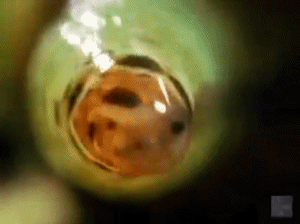Ah, the parasitic flatworms called trematodes. There's a lot of them, and many have very strange and impressive life cycles involving many specific hosts. Just about any of them is sci-fi worthy, but this one, in particular, is a real eye-catcher.
 Meet Leucochloridium paradoxum, also known as the green-banded broodsac. Like similar flatworms, its lifecycle involves two hosts. The adults, found in the guts of birds, lay eggs which land on the ground in the bird's droppings. The unfortunate host to follow, a snail (Succinea or Oxyloma), then eats the eggs, which hatch in its digestive system into small cilliated larvae called miracidia. These use their cilla (fiber-like structures) to move from the snail's gut to its eyestalk, where they transform into the next larval form called cercariae which create a nice little home for themselves in long tubes called sporocysts.
Meet Leucochloridium paradoxum, also known as the green-banded broodsac. Like similar flatworms, its lifecycle involves two hosts. The adults, found in the guts of birds, lay eggs which land on the ground in the bird's droppings. The unfortunate host to follow, a snail (Succinea or Oxyloma), then eats the eggs, which hatch in its digestive system into small cilliated larvae called miracidia. These use their cilla (fiber-like structures) to move from the snail's gut to its eyestalk, where they transform into the next larval form called cercariae which create a nice little home for themselves in long tubes called sporocysts.
It's these tubes that make these parasites so interesting. You see, the snails, on their own, aren't always the most tempting food for birds. They tend to hide a lot and are hard to see. But, seeing as the parasite needs to get into a bird's gut to continue its lifecycle, it isn't going to sit quietly and wait to get eaten. The tubes themselves mimic worms or caterpillars in appearance and movement, making them a tempting target for the parasite's adult hosts. On top of the visual attraction, the tubes serve another purpose - they blind the snail. So instead of avoiding open areas and sunlight, the snail wanders aimlessly into harms way. 



After a bird falls for the well-lain trap, the cercariae inside the sporocyst transform again, this time into the adult flatworms which feed off the bird's food and have sex so they can produce more little eggs to infect more unlucky snails. The snail is left to die or get re-infected - whichever happens first.
Just be glad that we don't get infected by trematodes. Oh, wait... we do. I guess I'll have to tell you more about those ones next week...
